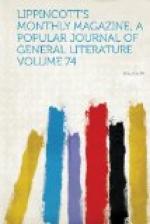Leaving the Nerbada we now struck off northward toward the Tonsa, intending to pass round by way of Dumoh, Sangor, Bhilsa and Sanchi to Bhopal. We might have pursued a route somewhat more direct by following directly down the valley of the Nerbada to Hoshangabad, and thence straight across to Bhopal, but my companion preferred the circuitous route indicated, as embracing a greater variety of interesting objects. He had procured for our conveyance a vehicle which was in all respects suitable to the placidity of his temper; and I make bold to confess that, American as I am—born on the railroad, so to speak—I have never enjoyed traveling as I did in this novel carriage. It was what is called a chapaya. It consisted of a body nearly ten feet in length by more than five in breadth, and was canopied by a top supported upon sculptured pillars of wood. The wheels were massive and low. There were no springs; but this deficiency was atoned for by the thick cushionment of the rear portion of the vehicle, which allowed us to lie at full length in luxurious ease as we rolled along. Four white bullocks, with humps and horns running nearly straight back on the prolongation of the forehead line, drew us along in a very stately manner at the rate of something like a mile and a half an hour.
We were now in the Gondwana, in some particulars one of the most interesting portions of the country. Here are the Highlands of Central India; here rise the Nerbada and the Tapti—which flow to the westward in a generally parallel direction, and empty into the Gulf of Cambaye, the one at Broode and the other at Surat—as well as the Son, the Keyn (or Cane) and the Tonsa, which flow northward into the Jumna. The valley of the Keyn and that of the Tonsa here run across the Vindhyas, which are known to the eastward of this as the Kyrmores, and afford communication between Northern and Southern India. It is along the depression of the latter stream that the railway has been built from Jabalpur to Allahabad.




